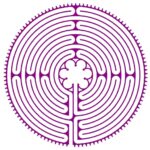While labyrinths were first used by Christian churches, they are not exclusive to the Christian tradition. There is actually nothing expressly Christian about the labyrinth. They can be a meaningful tool for meditation for people of all faiths and for those who are looking for ways to focus their thoughts, sort through options, center themselves, and calm their weary spirit.
Labyrinths are an ancient spiritual tool used for meditation and to simulate a pilgrimage. It combines the imagery of the circle and the spiral into a meandering but purposeful path.

A labyrinth offers you one single path which you follow to the center and then back out again. You cannot get lost and there are no dead ends. You can easily see where the labyrinth’s path is going, and where you are relative to the beginning and the center. You will cover the entire circular path during the walk. Simply following the path into the center and back out again can be a comforting ritual.
Walking and praying a labyrinth is a form of active meditation which can lead from yearning towards joy, meaning, hope, and peace. Using a labyrinth can calm the mind, relax the body, reduce stress and draw you into a deeper encounter with the Holy.
History of the Labyrinth
The labyrinth was a central feature in many of the European Roman Catholic churches in the Middle Ages and many of these still exist today. The most famous of these was laid into the floor of the Chartres Cathedral near Paris, France. This labyrinth was built around 1200. When taking an actual pilgrimage to Jerusalem became dangerous, walking the eleven-circuit labyrinth served as an acceptable substitute.
What a labyrinth is not
A labyrinth is not a maze – a maze has choices, dead ends. A maze requires you to make choices about which way you should go. Sometimes you’ll reach a dead end or get lost and need to turn around. Mazes are usually designed so the walker can’t see where the paths go and how to exit the maze.
